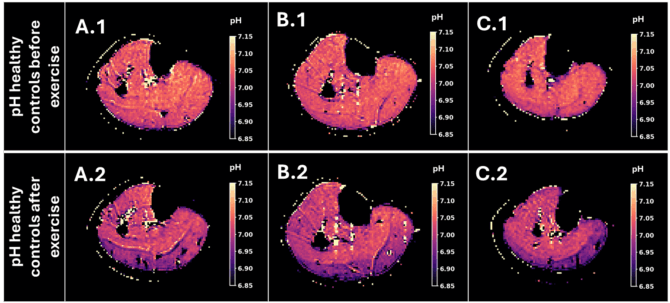 Valentin Henriet is a PhD student in the Nuclear Magnetic Resonance (NMR) Imaging and Spectroscopy Laboratory. The poster entitled ‘Creatine-CEST-based pH mapping in healthy volunteer leg muscles’ that he presented at the MYO-MRI+* conference was awarded the ‘Best Technical Poster’ prize. Interview.
Valentin Henriet is a PhD student in the Nuclear Magnetic Resonance (NMR) Imaging and Spectroscopy Laboratory. The poster entitled ‘Creatine-CEST-based pH mapping in healthy volunteer leg muscles’ that he presented at the MYO-MRI+* conference was awarded the ‘Best Technical Poster’ prize. Interview.
In what context did you carry out the work presented in this poster?
It has been shown that in certain neuromuscular diseases, muscle pH is slightly higher than in healthy muscle. There is currently an NMR method that can estimate the overall pH of a muscle volume, but this measurement is not localised and does not provide any spatial information (in other words, no image).
What were your objectives?
We wanted to find an imaging method that would enable us to obtain quantitative mapping of intramuscular pH, in order to obtain pixel-by-pixel pH values, study muscles independently of each other and see whether pH is homogeneous within the same muscle.
The ultimate aim is to use pH values as a predictive marker of disease. It begins to become disrupted at a very early stage, before irreversible fat replacement, which indicates that the disease has taken hold.
The idea was also to determine whether there are differences in pH between diseases and whether the muscles affected by a given pathology are all affected in the same way.
Ultimately, the aim is to predict the progression of certain neuromuscular diseases in order to provide patients with the appropriate care.
How did you proceed?
We made adjustments at every stage, starting with data acquisition. We had to optimise the way data was acquired using MRI to make the acquisition sensitive to certain parameters.
Then, the processing of this data is also very specific. It is based on a physical model that allows us to extract information relating to pH and thus reconstruct the maps. It’s a tailor-made development.
Example of pH mapping before (top) and after (bottom) a plantar flexion exercise,
showing the sensitivity of CEST-MRI to small pH variations in the physiological range.
____
* The 5th International Imaging in Neuromuscular Disease Conference organised by the MYO-MRI+ consortium was held in Berlin, Germany, from 9 to 11 November 2025.
** Physiological variation is extremely limited: in a diseased muscle, the pH ranges from 7.10 to 7.30; at rest, it ranges from 6.95 to 7.10. After exercise, during which lactic acid may be produced, the pH may drop to 6.80.
Download the poster

